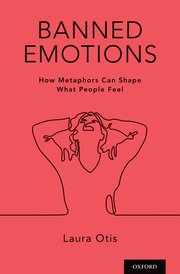
Laura Otis
Banned Emotions. How Metaphors Can Shape What People Feel
Oxford University Press
ISBN: 9780190698904
208 p.
35,9 $
PRÉSENTATION
Who benefits and who loses when emotions are described in particular ways? How do metaphors such as "hold on" and "let go" affect people's emotional experiences? Banned Emotions, written by neuroscientist-turned-literary scholar Laura Otis, draws on the latest research in neuroscience and psychology to challenge popular attempts to suppress certain emotions. This interdisciplinary book breaks taboos by exploring emotions in which people are said to "indulge": self-pity, prolonged crying, chronic anger, grudge-bearing, bitterness, and spite. By focusing on metaphors for these emotions in classic novels, self-help books, and popular films, Banned Emotions exposes their cultural and religious roots.
Examining works by Dante, Dickens, Dostoevsky, Kafka, Forster, and Woolf in parallel with Bridesmaids, Fatal Attraction, and Who Moved My Cheese?, Banned Emotions traces pervasive patterns in the ways emotions are represented that can make people so ashamed of their feelings, they may stifle emotions they need to work through. The book argues that emotion regulation is a political as well as a biological issue, affecting not only which emotions can be expressed, but who can express them, when, and how.
TABLE DES MATIÈRES
Acknowledgements
Chapter One: Introduction: Discouraging Metaphors
Chapter Two: The Bodily and Cultural Roots of Emotion Metaphors
Chapter Three: Wallowing in Self-Pity
Chapter Four: The Sound and Smell of Suffering
Chapter Five: Making Suffering Visible
Chapter Six: Detached and Circling: Metaphors for the Emotions of Women Scorned
Chapter Seven: Conclusion: Metaphors Matter in Emotion Regulation
Notes
Bibliography
LAURA OTIS
Laura Otis is a Professor of English at Emory University. With an MA in Neuroscience, a PhD in Comparative Literature, and an MFA in Fiction, she compares the creative thinking of scientists and literary writers. Otis, a MacArthur Fellow, is the author of Organic Memory, Membranes, Networking, Müller's Lab, and Rethinking Thought.
REVIEW
"An overwhelmed freshman tells me that she feels that she ought not to dump her emotions on others, and I realize for the first time, with shock, what view of human interiority this metaphor implies. This is what Laura Otiss powerful new book does to you. It stops you in your tracks, making you aware of how metaphors that we casually use to describe various unloved emotions, shape our self-perception, daily interactions, the novels that we read and the movies that we watch. It takes a scholar of Otiss brilliance and wide-ranging interdisciplinary expertise to bring together cognitive science and literary and film criticism in ways that can change how we think and live." - Lisa Zunshine, Bush-Holbrook Professor of English, University of Kentucky and author of Getting Inside Your Head: What Cognitive Science Can Tell Us about Popular Culture